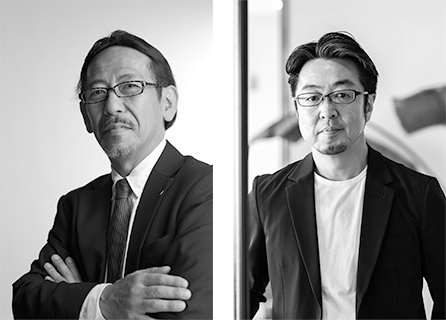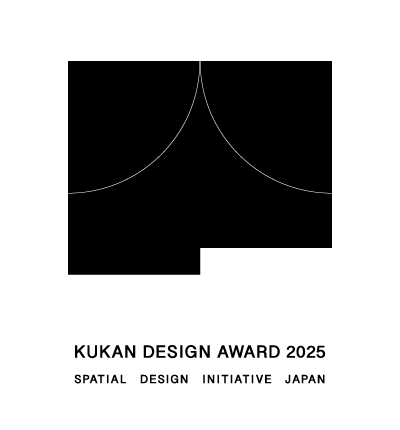About the KUKAN DESIGN AWARD
What is the KUKAN DESIGN AWARD?
Established to connect the value of spatial design to the future, the KUKAN DESIGN AWARD is the most esteemed of such awards in Japan.
As our society grows increasingly complex, our values too are changing, from valuing a wealth of things to valuing wealth in our hearts, and in this we face many challenges. The mission behind the KUKAN DESIGN AWARD is to mine the solutions of our society’s multi-faceted challenges and break through to a hopeful future.
Activities associated with the KUKAN DESIGN AWARD focus on creating places and opportunities for the myriad people passionate about design to assemble and collectively hone their craft. These activities bring to light new design values and talent, both domestic and international, and build a creative platform serving as an index for future generations.
In Japanese culture, the concept of KUKAN (space) regards not only physical space but also Ma (the space between)—between the hearts of those present in that space, the changes of affairs, and the passage of time. To design spaces is to create tremendous potential for people, society, and epochs.
Spatial design has the power to move people and enrich our society.
We believe in the power of spatial design.
Message from the president

In 2019, JCD and DSA merged their longstanding design awards to create the Japan Kukan Design Award, one of the largest space-related awards in Japan.
Kukan is a Japanese term meaning space, signifying not only physical spaces, but also the events and flow of time that occur there. Considering this broad sense of “space” as the realm for us designers, we established the mission of this award to discover the various views and values that emanate from it. We maintain the term “kukan” in the English translation, in an effort to introduce our message through design from Japan to the rest of the world.
Even if our world goes in an unexpected direction in the future, we will never give up on developing the importance and value of design. We would like to find the significance of this award as a place to discover and present them.
We invite designers from both Japan and overseas to this award to create a design trend together and pass on designs to the future.
Hidehito Izuhara, Chairperson of Japan Design Space Association (DSA)
Shigeru Kubota, President of Japan Commercial Environmental Design Association (JCD)
Organizer |
Japan Commercial Environmental Design Association |
|---|
Vision |
Creating new values of spatial design and building a creative society will lead to the enrichment of people’s lives and society. |
|---|
Purpose |
By finding outstanding designs and excellent designers and introducing them to the world, we will expand new possibilities of spatial design. |
|---|
Introduction of the host organization
Japan Design
|
 Aiming for Creation of Spatial Communication DesignSpatial design is about designing extremely highly interactive, impressive space by infusing messages that need to be delivered on the spot through the use of various techniques to enable articulation of ideas and offer thrilling and exciting experiences. Our activities as a group of creators focus on producing vibrant interactive space ranging from basic show windows & displays to exhibitions, showrooms, promotions, cultural, business and entertainment space, as well as architectural structures, cities, and landscapes. The Japan Design Space Association (DSA), in our official capacity as an incorporated association, is committed to pursuing public-interest activities that can contribute to economy, industry, society and culture through enhancing design technique advancements, organizing design awards, and facilitating symposiums, international exchanges, studies, publication and other promotional and educational activities. |
|---|
Japan Commercial
|
 Creating a new design for the commercial
|
|---|
Sponsoring
|
|
|---|
Cooperation |
|
|---|
Logo |
 Graphic design is two-dimensional and spatial design is three-dimensional, however functional design of both can be regarded as ‘four-dimensional’ integrating the fourth dimension ‘time’ such as aging, customer traffic line and the spirit of the times. In case of spatial design including towns and cities, for example, impression of a place when it is busy with tourists and when it is not is different. This is because change of time in the tourist season affects the shape of spatial design, which proves that space, cities and architecture are four-dimensional after thorough investigation. *1 Golden ratio…Ratio of rectangle discovered in the beauty of nature in ancient Greek, whose proportions are perfectly balanced. Issei Kitagawa / GRAPHRepresentative director of GRAPH. Born in 1965 in Kasai city, Hyogo prefecture. Member of AGI (Alliance Graphique Internationale) and jury member of NY ADC and D&AD Awards. Received many awards including TDC Awards and JAGDA New Designer Awards. He has been exploring technology to produce “printing which cannot be thrown away” and proposing “what the design should be as management resources” from the perspectives of both managers and designers, which attracted diverse clients from local small and medium-sized enterprises to international luxury brands. “Henn-na Hotel” which he took charge of its naming and branding received a certificate from Guinness World Records as “the world’s first hotel run by robots” in winter 2016. <Major exhibitions> |
|---|







